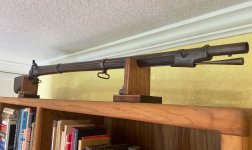I’m trying to figure out what my GrandfatherX2 might have carried during the Civil War.
He served the entirety of the war and started as a Private. He was of the Ohio volunteers.
I am most interested in the sword, but it may have been the M1850 foot officer’s sword, but if there are other possibilities I’d like to know.
I was also wondering, what type of firearm might he had carried as an officer?
As a private I’m sure it was whatever the standard issue was.
Would his weapons have changed with his rank or would he have ended up with a mix of what he had as the war progressed?
He served the entirety of the war and started as a Private. He was of the Ohio volunteers.
I am most interested in the sword, but it may have been the M1850 foot officer’s sword, but if there are other possibilities I’d like to know.
I was also wondering, what type of firearm might he had carried as an officer?
As a private I’m sure it was whatever the standard issue was.
Would his weapons have changed with his rank or would he have ended up with a mix of what he had as the war progressed?

